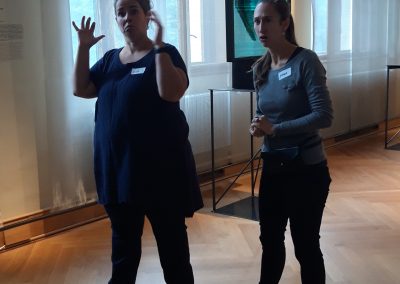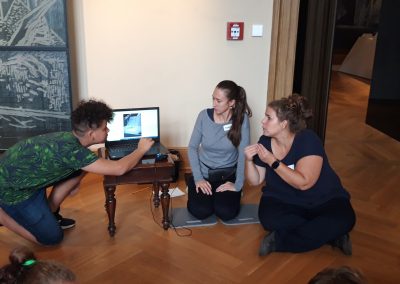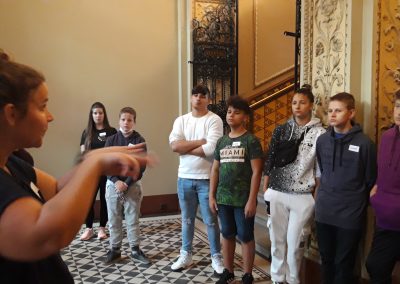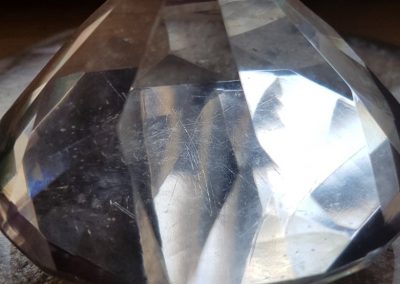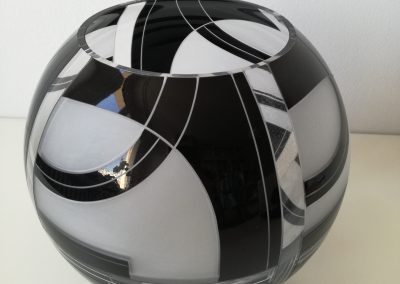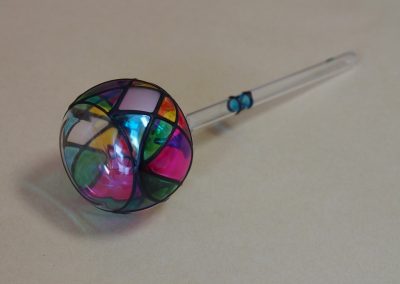

3.1 First visit
The aim of this part of the lesson is to demonstrate the notion that there are barriers that prevent some people from accessing culture and the art exhibited by galleries and museums. Visiting a museum is not that easy for everyone. Let us think about the kind of people who cannot go to a museum or a gallery even if they want to. What are the possible causes?
The deaf teacher Iva, whom you know from the introduction to the course, took her pupils to the museum to see the exhibition of Czech glass. For many of them, it was their first visit to an exhibition or a museum. Museum educators Dana and Vlaďka have stated that they had no prior experience working with deaf visitors. The museum’s programmes have not yet been adapted to the needs of this group of visitors in any way. Programmes for deaf visitors are not common practice in Czech cultural institutions. In order for such an event to take place, a lot of people had to meet at the museum. There were 11 pupils aged 11-14 let, Iva the art teacher, a class teacher, a teaching assistant, two interpreters, a transcriber from Czech sign language into written Czech, and two museum educators. You have already learnt about this in Unit 1.3. Communication, or how we understand each other.
In the first part of the programme, the pupils followed a presentation by educator Dana. In the second part, the pupils viewed glass exhibits in groups, noting their light and colour qualities. They used their phones to photograph interesting details.
Watch the videos below taken during the visit to the museum.
What do you think deaf visitors need in order to be able to participate in the museum’s educational programme? Which approaches were used during the programme and proved successful? Write your ideas in your notebook. Have you thought about the space and its layout? Is it something to do with the pupils’ independence and curiosity?
3.2 Mapping education

Figure 11 – Mapping of key concepts
Now, we are going to throw you in at the deep end. We have prepared 3 activities with questions and tasks for you. In the Figure 11 above, study the key concepts that have emerged from our analysis of the museum lessons. The map shows what was happening during the museum lessons; it contains important concepts that work relationally.

Activity 3.1
Let us consider the concept of SPACE: play the video once again and observe the exhibition space and architecture. Where are the pupils, the interpreter and the educator standing? Reflect on what kind of space is appropriate or inappropriate for communication in sign language. What view of the exhibits do the participants have? Record your responses in your notebook.
Let us consider the concept of EMANCIPATION: Does the concept have anything in common with communication and space? What could it possibly be? Record your responses in your notebook.
Let us consider the concept of COMMUNICATION: in what relationships do you find it on the map? Try to describe these relationships. Also, take a good look at the 3 pictures below (Figure 12, 13 and 14). Communication and understanding are prerequisites for deaf pupil’s participation in the programme. If a museum does not have a deaf educator, it is essential to provide interpretation. It is necessary to interpret the presentation and the educator’s instructions to the pupils, their teachers and assistants, and to interpret the deaf visitors’ questions and opinions back to the educators. Educational programmes for all groups of visitors are currently based on a discursive approach – that is, communication.
Consider why the group of deaf pupils needed two interpreters. We have already given you some clues. Write your reflections in your notebook.
You can learn about our experiences in below.
Our experience
SPACE: We understand space in both the physical and psychological sense of the word. All communication takes place in it. The analysis of education for the Deaf has shown the key importance of place and space in the communication and education of the Deaf. The exhibition space has turned out to be not very suitable for the needs of deaf visitors. The first stop took place on the museum’s staircase, on the way to the exhibition. The interpreters had to stand with their back turned to the window – next to the educator. The pupils who were standing on the staircase could not see their faces well, and thus could not read their facial expressions well (FIG. 12). After entering the first exhibition hall, the group spent a long time trying to determine how to locate themselves so that everyone could see each other well (FIG. 13). The exhibition tour led through narrow aisles between elevated pedestals, on which the exhibits were placed freely. In the aisles, the participants stood in a queue and blocked each other’s view (video time 18:00-32:00). The second hall with a more open architecture was better suited for communication among the Deaf. At the end of the video, you can see that the pupils, the educators and the interpreters all sit together in a circle (video time 2:09- 2:30; FIG. 14). This means that deaf visitors need enough open space in the exhibition to be able to communicate and discuss in a group, where everyone can see each other and where everyone can see the interpreters and educators well. A cramped and poorly lit space makes communication impossible. Simultaneously, during the presentation, deaf visitors need to be able to see the exhibits that are being talked about.
EMANCIPATION: The diagram above shows that emotions emerge and are experienced together in open communication in a common space. This is where trust can be built and emancipation can occur. Direct interaction with educator Dana, who does not have a hearing impediment, was a new experience for the deaf pupils. Deaf visitors are not used to being active participants in programmes because these programmes are not adapted for them. Deaf visitors need to be counted in. They need a friendly, forthcoming approach, respect and an opportunity for direct communication.
Procedures that have proved useful in teaching: object learning approaches, the possibility of haptic and holistic (bodily) perception, experiential learning, dialogic method, individual approach, group learning, openness towards further creative activity.
COMMUNICATION: Interpreting is very demanding. One interpreter can interpret for about an hour. It is more comfortable for interpreters to take turns after shorter intervals. Multidirectional communication was taking place in the group. It was necessary to interpret the communication of groups of deaf pupils working in parallel to the two educators, as well as to members of the research team.
3.3 Let us take the museum home
It is not possible to carry out artistic activities in the exhibition: galleries and museums use studios for this purpose. In this case, the deaf pupils travelled to the museum from afar and did not have time for creative activities. It was clear that the artistic follow-up would come later. It was agreed that an artist would pay a visit to the pupils at their school. In Unit 4, you will see how the visit unfolded. The following activity is another way to “move” the museum to another location. Try it out.

Activity 3.2
Create a museum at home. All you need is a wall, a spotlight and a mobile. What kind of glass do you have at home? Is there a glass object that you associate with a family member? What do you think of when you look at the selected glass object?
Arrange the glass object so that it best captures your recollection. Light it, turn it etc. Come up with a caption and add it to the object. Add the best executed photograph to the Home museum gallery, next to our examples:
Sharing beauty
Choose glassware that is suitable for a festive table. Come up with other artistic tasks involving glass, flowers, ornaments. Invite guests. Organise a (family) celebration. Document the celebration. Add the video or photos to the Celebration gallery Just like we did, as you can see in figure 18 below.
Credits & References
Figure 15 – My favourite vase. ©Photo: Marie Fulková, 2020
Figure 16 – Magdalena´s crystal. ©Photo: Magdalena Herelová, 2020
Figure 17 – Moe´s treasure. ©Photo: Moe Iezaki, 2020
Figure 18 – Garden party. ©Photo: Magdalena Novotná, 2020

